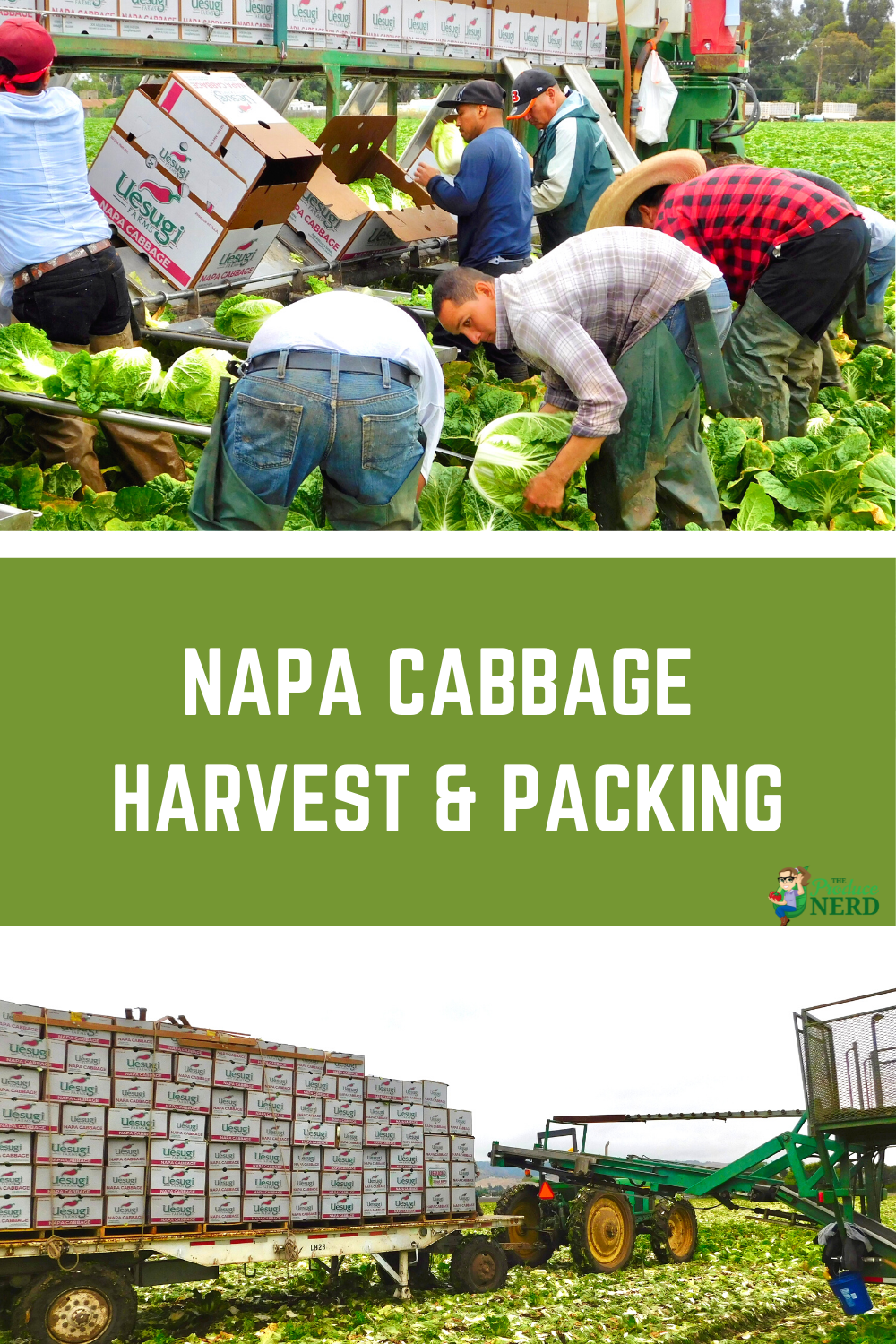Napa cabbage, also known as Chinese cabbage, is predominately grown for the specialty market. For those of you who enjoy Kimchi, it is made of fermented Napa cabbage! I recently went to Uesugi Farms in Gilroy, California to get a behind the scenes view of a Napa cabbage harvest. Napa cabbage is harvested and packed for the final consumer in the field, so there is no packinghouse step.
Table of Contents
How does Napa Cabbage differ from Regular Cabbage?
There are two main differences between Napa Cabbage and the more traditional cabbages that are sold:
- Flavor – Napa Cabbage is described as having a sweeter and milder flavor.
- Appearance – Napa Cabbage is larger, has a more oblong shape, is not as compact, and has large white ribs (like big veins) up the sides of the leaves.
As you can see in the picture below, they do not look similar at all! The Napa cabbage is also significantly larger in comparison.
How is Napa Cabbage Grown?
Napa cabbage is grown as a row crop, similar to most other leafy greens, such as head and romaine lettuces, as well as normal red and green cabbage.
As a result, they also have similar harvesting and packing procedures.
Napa Cabbage Harvest & Packing
During the harvesting operation, the harvesters work alongside harvesting equipment (also referred to as a harvesting rig) that moves through the field at the same rate as they do. This makes it so that the workers can continuously harvest as the equipment moves alongside them. In this way, there is less stress on the workers bodies and it makes the operation more efficient.
The Napa cabbage harvesting process is as follows:
- The harvesters select the heads of Napa cabbage that are of good quality to be harvested and harvest them, using a knife to cut the heads of Napa cabbage from the ground. They also remove the outer layers of leaves for quality and appearance purposes.
- The harvested Napa cabbage is placed onto the stainless steel packing table on the harvesting machine.
- The workers standing on the harvesting machine pack the Napa cabbage into boxes.
- Once the boxes are full, they are sent along a conveyor belt to another worker who staples the boxes shut. (I have received questions regarding the use of staples related to food safety practices. I have only seen staples being used to close boxes at this specific operation, and the worry is that the staples can get lost in the product.)
- The boxes continue on the conveyor belt to the adjacent trailer where the boxes are being loaded.
- When the trailer is full, it is moved to the outskirts of the field, until it is transported to the cooler. Another trailer will come up behind it to take its place in the field.
- A truck then comes to transport the packed trailer to the cooler.
The video below shows an overview of the Napa cabbage harvesting and in-field packing process.
Food Safety Considerations
For a harvesting and packing operation like this, some of the main food safety considerations are:
- Worker PPE – All workers need to wear the required personal protective equipment (PPE) that are cleaned on a regular basis and maintained by the company. In the example above, you can see that all workers are wearing gloves and leg covers to prevent any contamination from their clothes to the product.
- Sanitation of the harvesting tools – Knives are used to harvest the Napa cabbage. Those knives need to be cleaned, there needs to be a knife station for the knives to stay while the workers are on break or step away at any time from their harvesting duties, and the company needs to maintain the knives (e.g., they clean them, they store them overnight).
- Sanitation of the packing table and overall harvesting rig – The Napa cabbage goes from the field to the packing table to the box, so the packing table needs to be cleaned and sanitized on a scheduled basis to prevent any sort of contamination to the product.
- Adjacent land – There needs to be a large barrier between the growing area and any sort of animal activity. The growing area also needs to be in a position where it does not receive any runoff from adjacent land.
There are many more items to be taken into consideration, but this is just a brief list to get you thinking about it!
Postharvest Considerations
The most important thing that needs to happen postharvest is that the harvested Napa cabbage needs to be transported to the cooler as soon as possible. Napa cabbage, like other leafy greens, can withstand cool temperatures (as low as 0°C/32°F), and if stored properly throughout the distribution chain, they can last in storage for up to a few months.
Featured Grower Information
I would like to thank Uesugi Farms for the tour and for letting me share the gathered content. (Unfortunately, Uesugi Farms has since gone out of business since the date of my visit.)
If you enjoyed this post, you might also like:
